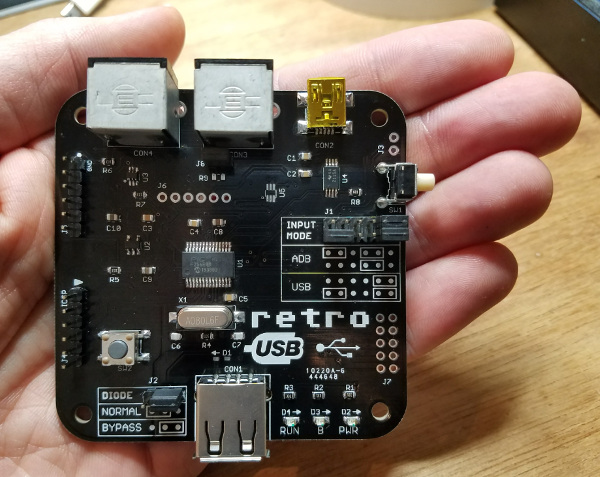First Hardware

Retro USB boards are here. They look pretty! And they actually work – minus some small fixes I had to apply.
I was in the midst of typing up a description about how my test board didn’t work, and feeling sorry for myself, when I remembered the issue with the external crystal that occurred with the breadboard prototype a few weeks ago. I couldn’t get the crystal to work reliably on the breadboard, so I substituted an external “can oscillator” for testing. That required changing some configuration bits for the PIC32’s clock source – bits that I forgot to change back once I had the real PCB. After I made that change, everything was good.
I’ll be very happy to retire the breadboard, with its delicate wiring that’s thrown off by the smallest bump, and switch over to a nice sturdy PCB for further development. Although within the first 10 minutes of use I already identified a long list of things I want to change about the PCB. For example, I located the serial port and ICSP headers too close to each other, so the PICKit3 programmer blocks the serial port. Doh! And a couple of the components I selected (like U3 in the photo) are way too tiny, and a real pain to solder. SOT-363 sounds fine when it’s some acronym, but perspective changes when you see it’s a 6-pin chip that’s the size of a sesame seed. I had to get a 10x loupe magnifier just to read the markings on the chip. But on the whole, the board seems completely usable, even though it makes some assembly and programming tasks slightly awkward. I think it’s a pretty good first attempt.
Read 9 comments and join the conversation9 Comments so far
Leave a reply. For customer support issues, please use the Customer Support link instead of writing comments.


Very nice, and those came a lot faster than I expected. Looking forward to final version.
The non-usb ports on this board… Are those still easy to buy?
ADB ports are standard 4-pin mini-DIN jacks, they are commonly available (same port used for S-Video).
Most excellent, Steve! Love my ADB keyboards, but by god– it’d be so nice to use an optical mouse with my old Macs!
A great achievement Steve. If it works as well as the Floppy Emu you’ll be on another winner.
The standby power feature works! With standby power, I turned on my Mac IIsi by pressing PRINT SCREEN on the USB keyboard. The physical power switch on the Retro USB board works too.
As of this afternoon, I think the firmware is feature complete. Everything that it’s supposed to do, it will do, at least on the hardware I’ve tried. Now I need to lay may hands on as many test systems, keyboards, and mice as I can find, which I’m sure will uncover a few bugs. Then it will be time for a soldering marathon.
You probably know this, but be sure to check an LC and perhaps a IIgs, I recall hearing that there is something different with their older implementations of ADB. A Belkin PS2 to ADB adapter won’t work with both keyboard and mouse on an LC for some reason. I have found that daisy chaining via ADB a 2nd adapter and using one for keyboard and one for mouse will work though…
These look great! Now I need to check my budget – I have a IIgs that i’d live to connect an optical mouse to. A question – do they work with a usb joystick?